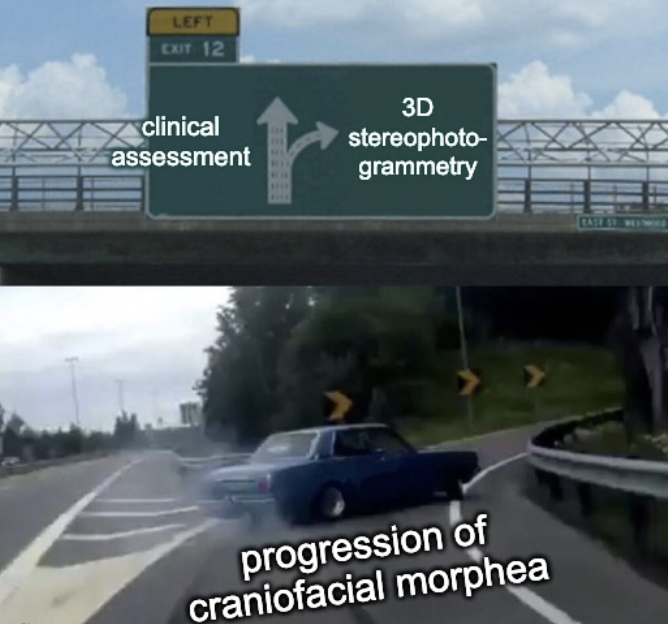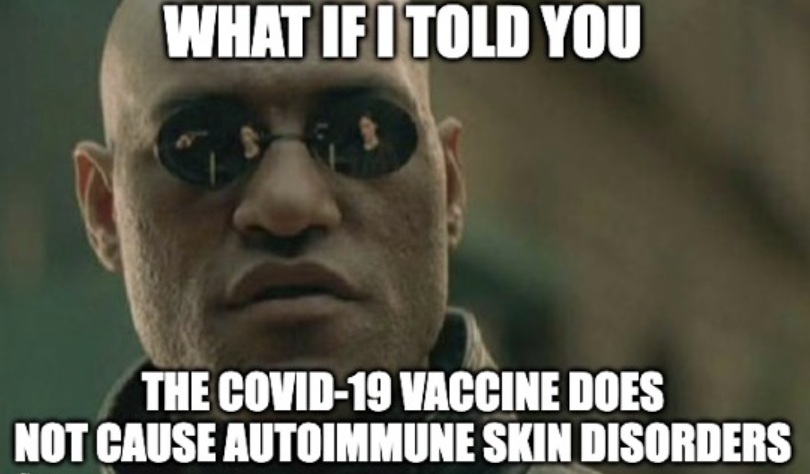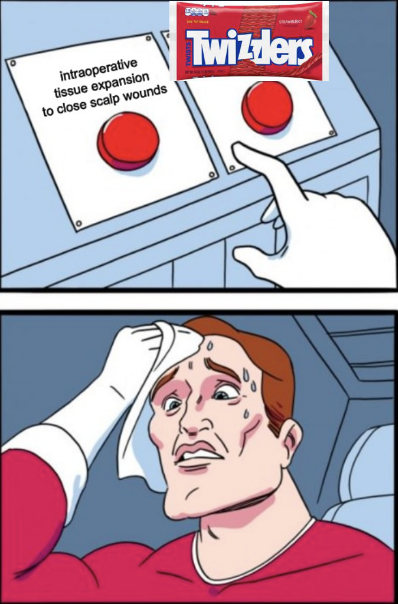Forty-Fifth ISSUE
October 18, 2023
Use of 3-dimensional stereophotogrammetry to detect disease progression in craniofacial morphea
JAMA Dermatology
JAMA Dermatology
AI is making its mark on dermatology!
Craniofacial morphea, an autoimmune disease which causes atrophy of the skin and soft tissue, is rare. Detecting subtle changes related to disease progression is challenging as clinical findings of disease progression are often lacking. This prospective cohort study followed 27 adolescent and adult patients over nearly 4 years, and utilized 3D stereophotogrammetry at 2- and 12-month intervals to assess for disease progression. This was compared to clinician expert evaluation of disease progression. Experts grading 3D images were blinded to clinical assessment.
What did they find?
Main Takeaway: As clinical detection of craniofacial morphea can be challenging, 3D stereophotogrammetry may be a useful adjunct to clinical assessment.
Craniofacial morphea, an autoimmune disease which causes atrophy of the skin and soft tissue, is rare. Detecting subtle changes related to disease progression is challenging as clinical findings of disease progression are often lacking. This prospective cohort study followed 27 adolescent and adult patients over nearly 4 years, and utilized 3D stereophotogrammetry at 2- and 12-month intervals to assess for disease progression. This was compared to clinician expert evaluation of disease progression. Experts grading 3D images were blinded to clinical assessment.
What did they find?
- Of 27 patients, 10 experienced disease progression based on clinical assessment
- All 10 patients with disease progression per clinical assessment had disease progression corroborated by 3D stereophotogrammetry
- 3D stereophotogrammetry had substantial interrater reliability (Cohen’s kappa 0.80, 95% CI 0.61-0.99)
- An additional 3 patients not detected by clinical assessment had occult disease progression identified by 3D stereophotogrammetry
Main Takeaway: As clinical detection of craniofacial morphea can be challenging, 3D stereophotogrammetry may be a useful adjunct to clinical assessment.
Risk of autoimmune skin and connective tissue disorders after mRNA-based COVID-19 vaccination
Journal of the American Academy of Dermatology
Journal of the American Academy of Dermatology
COVID vaccines: No skin-deep secrets to uncover!
In the wake of the COVID-19 pandemic, new-onset autoimmune manifestations following vaccination have been reported. However, the association between COVID-19 vaccination and autoimmune skin and connective tissue diseases has not been well-studied. To address this gap in the literature, a nationwide study of over 7.6 million individuals was conducted in South Korea: 3,838,120 vaccinated individuals (who received at least one dose) and 3,834,804 matched controls without any history of COVID-19 infection or vaccination were evaluated. Risk for the development of 17 unique autoimmune connective tissue diseases, within one year of vaccination, were analyzed.
What did they find:
Main takeaway: There appears to be minimal, if any, correlation between receiving the COVID-19 mRNA vaccination and risk of developing autoimmune skin and connective tissue disorders.
Limitations: This study was limited to a single ethnic group and the participant data lacked detailed information on individual factors such as genetic susceptibility or underlying disease. Additionally, the follow-up period was not long enough to assess potential long-term side effects of the vaccine.
In the wake of the COVID-19 pandemic, new-onset autoimmune manifestations following vaccination have been reported. However, the association between COVID-19 vaccination and autoimmune skin and connective tissue diseases has not been well-studied. To address this gap in the literature, a nationwide study of over 7.6 million individuals was conducted in South Korea: 3,838,120 vaccinated individuals (who received at least one dose) and 3,834,804 matched controls without any history of COVID-19 infection or vaccination were evaluated. Risk for the development of 17 unique autoimmune connective tissue diseases, within one year of vaccination, were analyzed.
What did they find:
- Compared to control, vaccinated individuals did not show statistically increased risk of developing alopecia areata, alopecia totalis, primary cicatricial alopecia, psoriasis, vitiligo, anti-neutrophil cytoplasmic antibody (ANCA)-associated vasculitis, sarcoidosis, Behcet disease, Crohn's disease, ulcerative colitis, rheumatoid arthritis, systemic lupus erythematosus, systemic sclerosis, Sjogren syndrome, ankylosing spondylitis, dermato/polymyositis, or bullous pemphigoid
- Although not statistically significant, the risk of bullous pemphigoid was increased in the vaccinated group
- Although not statistically significant, sex-stratified analysis revealed an increase of ANCA-associated vasculitis in vaccinated female individuals
- Of note, the specific type of mRNA COVID-19 vaccination received did not alter the risk of developing any of the conditions examined
Main takeaway: There appears to be minimal, if any, correlation between receiving the COVID-19 mRNA vaccination and risk of developing autoimmune skin and connective tissue disorders.
Limitations: This study was limited to a single ethnic group and the participant data lacked detailed information on individual factors such as genetic susceptibility or underlying disease. Additionally, the follow-up period was not long enough to assess potential long-term side effects of the vaccine.
Is the Twizzler technique an option for closing high tension scalp lesions after Mohs micrographic surgery?
Dermatologic Surgery Journal
Dermatologic Surgery Journal
Twizzler: a ~sweet~ wound closure technique!
Closing scalp defects after Mohs micrographic surgery (MMS) is often more challenging compared to lower tension areas. Although there are multiple closure methods, each comes with downfalls like sensory deficits, hair growth disruption, and blood loss.
This case series (n=50) evaluated the “Twizzler” technique, a form of intraoperative tissue expansion with running pulley suture, to close high-tension scalp wounds. Average defect width, physician aesthetic rating, and Patient and Observer Scar Assessment Scale (POSAS) 3.0 were assessed.
How does the Twizzler technique work?
What did they find?
Main Takeaways: The Twizzler technique is a viable option for single-stage closure of high tension MMS defects on the scalp with high patient satisfaction, despite some complications.
Closing scalp defects after Mohs micrographic surgery (MMS) is often more challenging compared to lower tension areas. Although there are multiple closure methods, each comes with downfalls like sensory deficits, hair growth disruption, and blood loss.
This case series (n=50) evaluated the “Twizzler” technique, a form of intraoperative tissue expansion with running pulley suture, to close high-tension scalp wounds. Average defect width, physician aesthetic rating, and Patient and Observer Scar Assessment Scale (POSAS) 3.0 were assessed.
How does the Twizzler technique work?
- Place a 3-0 polypropylene running suture along full length of the defect with extra suture free at the ends
- Pull ends of suture to approximate wound and hold for 60 seconds
- Relax tissue for 2-4 minutes
- Reapply force to approximate wound for 60-90 seconds
- Deep dermal 4-0 Monocryl suture placed - not secured - between running stitches; deep stitches were clamped with a hemostat
- Tension was reapplied for 60-90 seconds, and secured with slip knot on both ends
What did they find?
- Mean defect diameter was 2.0 cm; mean closure length was 5.7 cm
- Cosmetic evaluation (subset of n = 25):
- “excellent” or “very good” reconstruction outcomes 60% of the time; average cosmetic score of 3.71 (scale 1-5)
- Suture track marks detected in 51% of cases
- Hair loss detected in 30% of cases on hair bearing scalp
- “excellent” or “very good” reconstruction outcomes 60% of the time; average cosmetic score of 3.71 (scale 1-5)
- Excellent reported patient satisfaction
- 2 cases of surgical site infection, 3 cases of would edge dehiscence which healed successfully with secondary intent, 2 cases of mild postoperative bleeding
Main Takeaways: The Twizzler technique is a viable option for single-stage closure of high tension MMS defects on the scalp with high patient satisfaction, despite some complications.
Topical application of a PDE4 inhibitor ameliorates atopic dermatitis through inhibition of basophil IL-4 product
Journal of Investigative Dermatology
Journal of Investigative Dermatology
AT difamiLAST: the mechanism of PDE4 inhibitors explained!
The precise pathogenesis of atopic dermatitis (AD) is unknown; however, studies have demonstrated that IL-4, a basophil-producing inflammatory cytokine, contributes to disease development. PDE4 catalyzes cAMP degradation intracellularly; inhibition of PDE4 leads to increased intracellular cAMP, blocking production of inflammatory molecules in various cell types. Topical PDE4 inhibitors have shown therapeutic benefit in AD, but the mechanism of action is not fully understood.
Researchers used oxazolone (OX) to induce an AD-like skin inflammation model in wildtype, IL-4 knockout, and basophil-depleted mice. Mice were treated with difamilast, a topical PDE4 inhibitor, and skin inflammation was compared between groups. Skin inflammation was measured by changes in skin thickening, histopathology, and infiltration of inflammatory cells in skin lesions.
What did they find?
Main takeaways: Difumilast, a topical PDE4 inhibitor, treats atopic dermatitis through the inhibition of IL-4 production within basophils.
The precise pathogenesis of atopic dermatitis (AD) is unknown; however, studies have demonstrated that IL-4, a basophil-producing inflammatory cytokine, contributes to disease development. PDE4 catalyzes cAMP degradation intracellularly; inhibition of PDE4 leads to increased intracellular cAMP, blocking production of inflammatory molecules in various cell types. Topical PDE4 inhibitors have shown therapeutic benefit in AD, but the mechanism of action is not fully understood.
Researchers used oxazolone (OX) to induce an AD-like skin inflammation model in wildtype, IL-4 knockout, and basophil-depleted mice. Mice were treated with difamilast, a topical PDE4 inhibitor, and skin inflammation was compared between groups. Skin inflammation was measured by changes in skin thickening, histopathology, and infiltration of inflammatory cells in skin lesions.
What did they find?
- OX-induced mice treated with difamilast showed a decrease in skin inflammation compared to controls
- OX-induced IL-4 knockout mice showed no change in skin inflammation compared to OX-induced wildtype mice when both groups were treated with difamilast, suggesting that difamilast may inhibit IL-4
- OX-induced basophil-depleted mice showed no change in skin inflammation compared to OX-induced wildtype mice when both groups were treated with difamilast, suggesting that difamilast may inhibit basophil infiltration
- In OX-induced mice, the number of basophils in the skin lesions did not change, but showed reduced expression of IL-4 in basophils after difumilast treatment, suggesting that difumilast inhibits IL-4 expression in basophils
Main takeaways: Difumilast, a topical PDE4 inhibitor, treats atopic dermatitis through the inhibition of IL-4 production within basophils.
What are the impacts of low-molecular-weight-collagen peptides on the integrity of the skin?
Journal of Cosmetic Dermatology
Journal of Cosmetic Dermatology
Collagen: your skin's secret sauce for ageless allure!
Given collagen’s vital role in our skin’s integrity, cosmetic supplements have gained popularity, but the question remains: what do collagen supplements really do for your skin? In this randomized, double-blinded, placebo controlled clinical trial, researchers aimed to evaluate the impact of low-molecular-weight collagen peptides on human skin.
Healthy adult participants with dry skin and periorbital wrinkles (n=100) were assigned to the test product group (low-molecular-weight collagen peptides) or the placebo group. Participants took the powder treatment once daily, in the morning before a meal, for 12 weeks. Assessment of wrinkles, hydration and elasticity was conducted at baseline week 0 and again at weeks 4, 8, and 12.
What did they find:
Main takeaway: Oral consumption of low-molecular-weight collagen peptides for 12 weeks reduced wrinkles, improved elasticity, and enhanced skin hydration.
Limitations: Follow-up assessment was not conducted after the test product was discontinued, the qualitative nature of this study does not readily translate to clinical appearance, the study was conducted using a product versus a pure ingredient, the study enrolled patients from specific regions in Korea of specific sex and age groups and thus may not be generalizable.
Given collagen’s vital role in our skin’s integrity, cosmetic supplements have gained popularity, but the question remains: what do collagen supplements really do for your skin? In this randomized, double-blinded, placebo controlled clinical trial, researchers aimed to evaluate the impact of low-molecular-weight collagen peptides on human skin.
Healthy adult participants with dry skin and periorbital wrinkles (n=100) were assigned to the test product group (low-molecular-weight collagen peptides) or the placebo group. Participants took the powder treatment once daily, in the morning before a meal, for 12 weeks. Assessment of wrinkles, hydration and elasticity was conducted at baseline week 0 and again at weeks 4, 8, and 12.
What did they find:
- Skin roughness and wrinkle depth significantly improved in the test group compared to the placebo group at 12 weeks (p<0.0001)
- Hydration of the forehead, forearms, cheeks, and lower eyelids was enhanced in the test group at 4, 8, and 12 weeks compared to baseline (p<0.0001)
- Overall elasticity was significantly improved in the test group compared to the placebo group at 8 and 12 weeks (p<0.001)
Main takeaway: Oral consumption of low-molecular-weight collagen peptides for 12 weeks reduced wrinkles, improved elasticity, and enhanced skin hydration.
Limitations: Follow-up assessment was not conducted after the test product was discontinued, the qualitative nature of this study does not readily translate to clinical appearance, the study was conducted using a product versus a pure ingredient, the study enrolled patients from specific regions in Korea of specific sex and age groups and thus may not be generalizable.
Introduction: Existing scoring systems for epidermal necrolysis (EN) only predict patient prognosis and are heavily weighted towards comorbidities and systemic features. Furthermore, terms used to describe the disease lesions are inconsistent, and it is unclear if certain skin locations are disproportionately affected.
We attempted to establish a consensus among expert dermatologists in disease terminology, morphologic progression, and typical anatomic sites for EN, and to use this consensus as a framework to guide the development of a skin-directed scoring assessment in EN. Our team developed a Delphi consensus using the RAND/UCLA appropriateness criteria, and we surveyed 54 experts from the Society of Dermatology Hospitalists.
What did we find:
Limitations: EN is a rare disease, so even experts who treat the disease regularly see only a few cases per year.
Main Takeaway: Our team’s consensus exercise has revealed a need and established baseline consensus for a standardized instrument with consistent terminology to be used in EN.
Reflection: This was such a formative experience for me as I was able to learn methods of establishing a mathematical consensus, collaborate with over 50 extremely busy physicians from over 40 different hospital systems, and present my work at the national level. I feel so grateful to see all our hard work come to fruition!
We attempted to establish a consensus among expert dermatologists in disease terminology, morphologic progression, and typical anatomic sites for EN, and to use this consensus as a framework to guide the development of a skin-directed scoring assessment in EN. Our team developed a Delphi consensus using the RAND/UCLA appropriateness criteria, and we surveyed 54 experts from the Society of Dermatology Hospitalists.
What did we find:
- Our experts consistently agreed on the need for a skin-specific instrument
- The head and neck, chest, upper back, ocular mucosa, and oral mucosa were agreed to be sites that were almost always affected by EN, and they agreed on specific terms to be applied to EN morphologic terminology
Limitations: EN is a rare disease, so even experts who treat the disease regularly see only a few cases per year.
Main Takeaway: Our team’s consensus exercise has revealed a need and established baseline consensus for a standardized instrument with consistent terminology to be used in EN.
Reflection: This was such a formative experience for me as I was able to learn methods of establishing a mathematical consensus, collaborate with over 50 extremely busy physicians from over 40 different hospital systems, and present my work at the national level. I feel so grateful to see all our hard work come to fruition!






